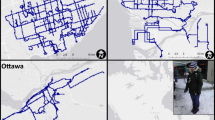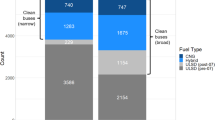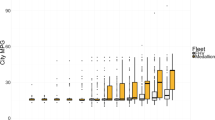Abstract
Real-time and integrated measurements of gaseous and particulate pollutants were conducted inside five conventional diesel school buses, a diesel bus with a particulate trap, and a bus powered by compressed natural gas (CNG) to determine the range of children's exposures during school bus commutes and conditions leading to high exposures. Measurements were made during 24 morning and afternoon commutes on two Los Angeles Unified School District bus routes from South to West Los Angeles, with seven additional runs on a rural/suburban route, and three runs to test the effect of window position. For these commutes, the mean concentrations of diesel vehicle-related pollutants ranged from 0.9 to 19 μg/m3 for black carbon, 23 to 400 ng/m3 for particle-bound polycyclic aromatic hydrocarbon (PB-PAH), and 64 to 220 μg/m3 for NO2. Concentrations of benzene and formaldehyde ranged from 0.1 to 11 μg/m3 and 0.3 to 5 μg/m3, respectively. The highest real-time concentrations of black carbon, PB-PAH and NO2 inside the buses were 52 μg/m3, 2000 ng/m3, and 370 μg/m3, respectively. These pollutants were significantly higher inside conventional diesel buses compared to the CNG bus, although formaldehyde concentrations were higher inside the CNG bus. Mean black carbon, PB-PAH, benzene and formaldehyde concentrations were higher when the windows were closed, compared with partially open, in part, due to intrusion of the bus's own exhaust into the bus cabin, as demonstrated through the use of a tracer gas added to each bus's exhaust. These same pollutants tended to be higher on urban routes compared to the rural/suburban route, and substantially higher inside the bus cabins compared to ambient measurements. Mean concentrations of pollutants with substantial secondary formation, such as PM2.5, showed smaller differences between open and closed window conditions and between bus routes. Type of bus, traffic congestion levels, and encounters with other diesel vehicles contributed to high exposure variability between runs.
This is a preview of subscription content, access via your institution
Access options
Subscribe to this journal
Receive 6 print issues and online access
$259.00 per year
only $43.17 per issue
Buy this article
- Purchase on Springer Link
- Instant access to full article PDF
Prices may be subject to local taxes which are calculated during checkout






Similar content being viewed by others
References
Alm S., Jantunen M.J., and Vartiainen M. Urban commuter exposure to particle matter and carbon monoxide inside an automobile. J Exp Anal Environ Epidemiol 1999: 9: 237–244.
Ayala A.N., Kado R., Okamoto M., Rieger P., Holmen B.A., and Stiglitz K. ARB's study of emission from two “late-model” diesel and CNG heavy-duty transit buses. 12th CRC On-Road Vehicle Emissions Workshop, April 15–17, 2002, San Diego.
Batterman S.A., Peng C.-Y., and Braun J. Levels and composition of volatile organic compounds on commuting routes in Detroit, Michigan. Atmos Environ 2002: 36: 6015–6030.
Behrentz E., Fitz D.R., Pankratz D., Sabin L.D., Colome S.D., Fruin S.A., and Winer A.M. Measuring self pollution in school buses using a tracer gas technique. Atmos Environ 2004a: 38: 3735–3746.
Behrentz E., Sabin L.D., Winer A.M., Colome S.D., Fitz D.R., Pankratz D.V., and Fruin S.A. Relative importance of school bus-related microenvironments to children's pollutant exposure. J Air Waste Manage Assoc 2004b, in press.
Benner B.A., Gordon G.E., and Wise S.A. Mobile sources of atmospheric polycyclic aromatic hydrocarbons: a roadway tunnel study. Environ Sci Technol 1989: 23: 1269–1278.
California Air Resources Board (CARB). The 2004 California Almanac of Emissions and Air Quality. Air Quality Data Branch: Sacramento, CA, 2004.
Chung A., Chang D.P.Y., Kleeman M.J., Perry K.D., Cahill T.A., Duther D., McDougall E.M., and Stroud K. Comparison of real-time instruments used to monitor airborne particulate matter. J Air Waste Manage Assoc 2001: 51: 109–120.
Finlayson-Pitts B.J., and Pitts J.N. Chemistry of the Upper and Lower Atmosphere. Academic Press, San Diego, CA, 2000, pp. 4–7, 17–18.
Fitz D.R., Pankratz D.V., Bumiller K., and Smith M.R. Measurement of NO2 and PAN by gas chromatography with luminol detection. Air and Waste Management Association Symposium on Air Quality Measurement Methods and Technology. San Francisco, CA, November 13–15, 2002.
Fitz D., Winer A.M., Colome S., Behrentz E., Sabin L.D., Jeong S., Wong K., Kozawa K., Pankratz D., Bumiller K., Gemmill D., and Smith M. Characterizing the Range of Children's Pollutant Exposure During School Bus Commutes, Final Report. Contract No. 00-322. California Air Resources Board, Research Division, Sacramento, CA, 2003.
Fung K., and Grosjean D. Determination of nanogram amounts of carbonyls as 2,4-dinitrophenylhydrazones by high performance liquid chromatography. Anal Chem 1981: 53: 168–171.
Fung K., and Wright B. Measurement of formaldehyde and acetaldehyde using 2,4-dinitrophenylhydrazine-impregnated cartridges during the carbonaceous species methods comparison study. Aero Sci Technol 1990: 12: 44–48.
Fruin S.A., Winer A.M., and Rodes C.E. Black carbon concentrations in California vehicles and estimation of in-vehicle diesel exhaust particulate matter exposures. Atmos Environ 2004: 38: 4123–4133.
Hughes L.S., Allen J.O., Bhave P., Kleeman M.J., and Cass G.R. Evolution of atmospheric particles along trajectories crossing the Los Angeles Basin. Environ Sci Technol 2000: 34: 3058–3068.
Johnson T.V. Diesel emission control in review. SAE Technical paper No. 2001-01-0184, 2001.
Kirchstetter T.W., and Harley R.A. Impact of Reformulated Fuel on Particle and Gas-Phase Emissions from Motor Vehicles. Final Report. Contract No. 00-322. California Air Resources Board, Research Division, Sacramento, CA, 1999.
Lawryk N.J., and Weisel C.P. Exposure to volatile organic compounds in the passenger compartment of automobiles during periods of normal and malfunctioning operation. J Exp Anal Environ Epidemiol 1995: 5: 511–531.
Lawson D.R., Biermann H.W., Tuazon E.C., Winer A.M., Mackay G.I., Schiff H.I., Kok G.L., Dasgupta P.D., and Fung K. Formaldehyde measurement methods evaluation and ambient concentrations during the carbonaceous species methods comparison study. Aero Sci Technol 1990: 12: 64–76.
Lipsett M The Hazards of Air Pollution to Children. In: Brooks S. et al. (Eds). Environmental Medicine.. Mosby: St. Louis, MO, 1989.
Ptak T.J., and Fallon S.L. Particulate concentration in automobile passenger compartments. Particulate Sci Technol 1994: 12: 313–322.
Ramachandran G., Adgate J.L., Hill N., Sexton K., Pratt G.C., and Bock D. Comparison of short-term variations (15-minute averages) in outdoor and indoor PM2.5 concentrations. J Air Waste Manage Assoc 2000: 50: 1157–1166.
Rodes C., Sheldon L., Whitaker D., Clayton A., Fitzgerald K., Flanagan J., DiGenova F., Hering S., and Frazier C. Measuring Concentrations of Selected Air Pollutants Inside California Vehicles. Final Report. Contract No. 95-339. California Air Resources Research Division Board, Sacramento, CA, 1998.
Shikiya D.C., Liu C.S., Hahn M.I., Juarros J., and Barcikowski W. In-Vehicle Air Toxics Characterization Study in the South Coast Air Basin. Final Report. South Coast Air Quality Management District, El Monte, CA, 1989.
Solomon G.M., Campbell T.R., Feuer G.R., Masters J., Samkian A., and Paul K.A. No Breathing in the Aisles: Diesel Exhaust Inside School Buses. Natural Resources Defense Council and Coalition for Clean Air, New York, NY, 2001.
Turner W.A., Olson B.A., and Allen G.A. Calibration of sharp cut impactors for indoor and outdoor particle sampling. J Air Waste Manage Assoc 2000: 50: 484–487.
U.S. Environmental Protection Agency (US EPA). Compendium of Methods for the Determination of Toxic Organic Compounds in Ambient Air. Document EPA-600/4-89-017, 1989.
Venkataraman C., Lyons J.M., and Friedlander S.K. Size distributions of polycyclic aromatic hydrocarbons and elemental carbon. 2. Ambient measurements and effects of atmospheric processes. Environ Sci Technol 1994: 28: 563–572.
Wargo J., Brown D., Cullen M., Addiss S., and Alderman N. Children's Exposure to Diesel Exhaust on School Buses. Environmental and Human Health, Inc., North Haven, CT, 2002.
Wiley J.A., Robinson J.P., Cheng Y.T., Piazza T., Stork L., and Plasden K. Study of Children's Activity Patterns. Contract No. A. 773-149. California Air Resources Board, Research Division, Sacramento, CA, 1991.
Yanosky J.D., Williams P.L., and Macintosh D.L. A comparison of two direct-reading aerosol monitors with the Federal Reference Method for PM2.5 in indoor air. Atmos Environ 2002: 36: 107–113.
Zhu Y., Hinds W.C., Kim S., Shen S., and Sioutas C. Study of ultrafine particles near a major highway with heavy-duty diesel traffic. Atmos Environ 2002a: 36: 4323–4335.
Zhu Y., Hinds W.C., Kim S., and Sioutas C. Concentration and size distribution of ultrafine particles near a major highway. J Air Waste Manage Assoc 2002b: 52: 1032–1042.
Acknowledgements
We gratefully acknowledge support for this research from the ARB, Contract No. 00-322, and the SCAQMD and US EPA. The statements and conclusions in this document are those of the authors and not necessarily those of these agencies. We appreciate the cooperation of the Brentwood Science Magnet School and the LAUSD. We wish to acknowledge valuable technical support from Kurt Bumiller and Matt Smith of CE-CERT, UC Riverside. We thank our bus driver, Shonna Pierce, and Kenneth Wong and Kathleen Kozawa from the Department of Environmental Health Sciences for their contributions.
Author information
Authors and Affiliations
Corresponding author
Rights and permissions
About this article
Cite this article
Sabin, L., Behrentz, E., Winer, A. et al. Characterizing the range of children's air pollutant exposure during school bus commutes. J Expo Sci Environ Epidemiol 15, 377–387 (2005). https://doi.org/10.1038/sj.jea.7500414
Received:
Accepted:
Published:
Issue Date:
DOI: https://doi.org/10.1038/sj.jea.7500414



